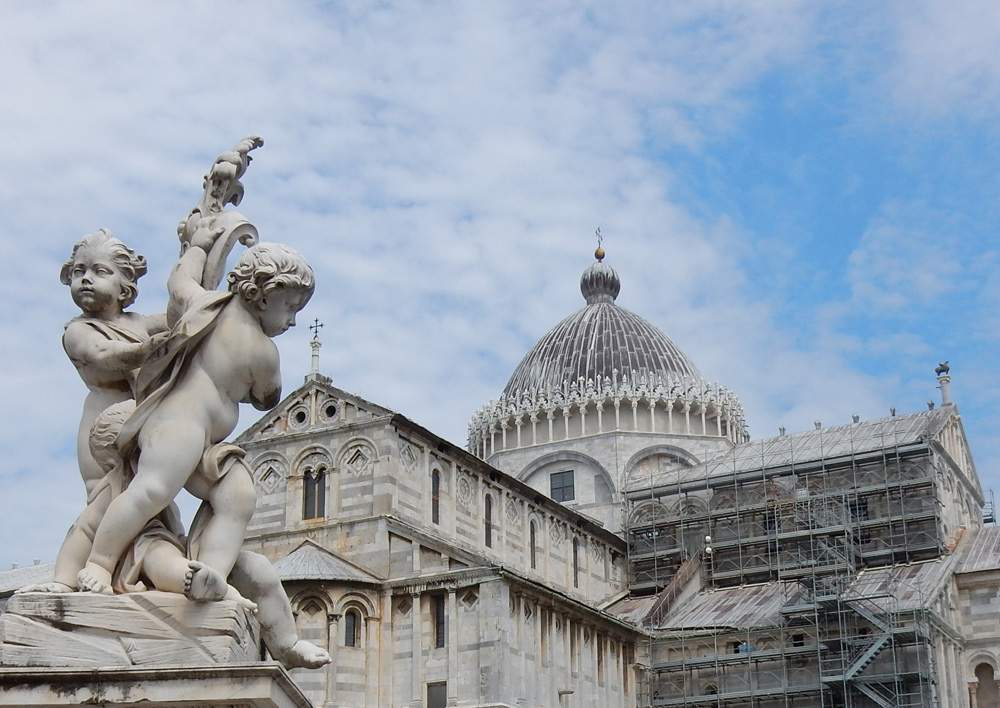The restoration of the second lot of the apsidal head of the Cathedral of Santa Maria Assunta in Pisa has been completed: it covers an area of about 1,300 square meters that includes the north and south sides of the choir and clerestory and the drum of the dome. The intervention is part of a wide-ranging program of conservative restoration involving the entire Cathedral: started with the façade in the 1990s, in view of the 2000 Jubilee, the program was then suspended for almost ten years and resumed in 2012 with a pilot site, an area of about 160 square meters of stone surface on which methodologies, materials, timing and investigations were fine-tuned, necessary to ensure the correctness of the restoration work. This experimentation was followed by the first batch of work, also conducted on the apsidal head of Pisa Cathedral, and in 2016 the second batch, which has just been completed, was started.
Many results have been obtained from this important restoration. Indeed, the construction site of the dome has made it possible to tackle a wide-ranging study, interweaving the conservation and restoration work with the historical-artistic investigation, the analysis of construction techniques, the study of reused ancient marbles and their provenance, the analysis of ancient surface treatments and their alterations, and, finally, with the scientific research of new nanometric materials for restoration. The work was conducted by the restorers of the Opera della Primaziale Pisana in collaboration with the Universities of Pisa and Siena and several professionals (including art historians, engineers, architects and archaeologists) who allowed the full and proper conduct of these important multidisciplinary studies, capable of restoring a complete “vision” of the dome of the Duomo. A second phase then involved the Department of Physical, Earth and Environmental Sciences of the University of Siena and the Department of Earth Sciences of the University of Pisa for the study of materials and patinas, so that the most correct decisions could be made for restoration work.
A restoration that became necessary because of the degradation that had begun to affect the dome, and due to the type of surface workmanship of the stone, exposure to weathering, historical vicissitudes, as well as the orientation of the dome itself. Indeed, it has been observed that the south-facing side has suffered more than the others from erosion, disintegration and exfoliation phenomena due to the greater range of temperature and humidity, as well as direct sunlight. For the opposite reason, the north side, on the other hand, had been “colonized” by plants, mosses, lichens, and algae. Therefore, the surfaces were cleaned, before moving on to structural consolidation operations on the pinnacles of the dome and the corbels of the gables. The disintegrated surfaces of the capitals were also consolidated with suitable products to reconstitute the cohesion of the constituent material and increase its mechanical strength.
Finally, the last phase of the intervention involved grouting all the joints of the stone elements with traditional mortars based on slaked lime and inert and hydraulic aggregates. Similarly, continuity was given to the stone face with the micro grouting of fractures and deficiencies to prevent water infiltration with consequent biological colonization and disintegration phenomena due to freeze-thaw cycles in the winter months. Of particular importance and international significance was the incorporation of the European Nano-Cathedral project into the restoration site of the stone surfaces of Pisa Cathedral. The application of new nano-technologies in this area will make it possible to develop products corresponding to the requirements of compatibility, eco-sustainability, effectiveness and efficiency to protect the monumental artistic heritage over time.
 |
| Pisa Cathedral, finishes restoration of second batch of apsidal headboard |
Warning: the translation into English of the original Italian article was created using automatic tools. We undertake to review all articles, but we do not guarantee the total absence of inaccuracies in the translation due to the program. You can find the original by clicking on the ITA button. If you find any mistake,please contact us.